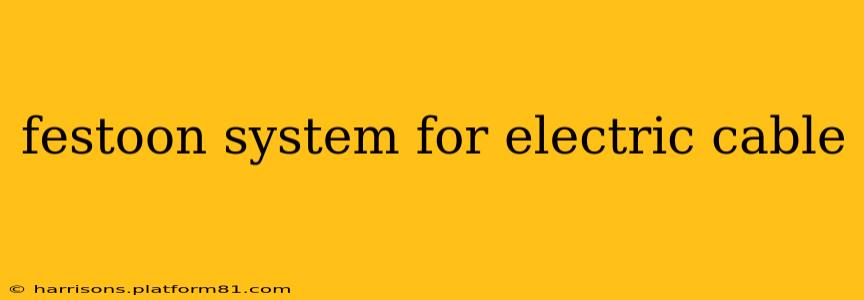Festoon systems are crucial for safely and effectively managing electrical cables in dynamic environments. They provide a flexible, durable, and reliable solution for applications where cables need to move repeatedly without risk of damage or entanglement. This comprehensive guide delves into the intricacies of festoon systems, addressing common questions and providing valuable insights for those seeking to understand and implement these essential industrial components.
What is a Festoon System?
A festoon system is a specialized cable management system designed to support and protect electrical cables, hoses, and other flexible conduits in applications involving continuous movement. It typically consists of a series of carriers, or trolleys, that move along a track. These carriers support the cables, allowing them to move freely while remaining protected from abrasion, crushing, and environmental factors. The system allows for easy extension and retraction of cables, maintaining their integrity even under constant flexing. Think of it as a sophisticated clothesline for your industrial cables, but far more robust and engineered for demanding situations.
What are the Different Types of Festoon Systems?
Several types of festoon systems exist, each designed for specific applications and load requirements. These include:
- Top Running Festoon Systems: These are the most common type, with the track mounted above the application. Cables are supported from above, typically used in overhead crane applications.
- Bottom Running Festoon Systems: Similar to top running systems, but the track is mounted below, suitable for situations where overhead mounting is impractical.
- Vertical Festoon Systems: These systems are designed for vertical movement, often seen in elevators or other vertical transportation systems.
- Articulated Arm Festoon Systems: These systems use articulated arms to reach specific points, providing a more flexible solution for complex layouts.
What are the Benefits of Using a Festoon System?
Festoon systems offer numerous advantages over alternative cable management methods:
- Increased Cable Lifespan: Protection from abrasion and kinking significantly extends the life of your cables, reducing replacement costs and downtime.
- Improved Safety: Organized cabling minimizes tripping hazards and prevents accidental cable damage.
- Enhanced Productivity: Smooth cable movement ensures uninterrupted operation of machinery and equipment.
- Easy Maintenance: Most festoon systems allow for easy access to cables for inspection and maintenance.
- Customizable Solutions: Systems can be tailored to specific applications and environments, ensuring a perfect fit.
What are the Common Applications of Festoon Systems?
Festoon systems find application in a wide range of industries and applications where cables need to move freely, including:
- Overhead Cranes: A primary application, supporting power and control cables for cranes in factories and warehouses.
- Automated Guided Vehicles (AGVs): Providing power and communication to AGVs in manufacturing and logistics facilities.
- Conveyor Systems: Ensuring reliable power and data transmission for moving conveyor belts.
- Stage Lighting and Production: Supporting heavy-duty lighting and power cables for theatrical productions and concerts.
- Industrial Robotics: Allowing for flexible cable management in robotic workcells.
How Much Does a Festoon System Cost?
The cost of a festoon system varies greatly depending on several factors, including the length of the track, the number of carriers, the cable capacity, and the complexity of the system. It's best to consult with a festoon system supplier to obtain a precise quote based on your specific requirements. The initial investment, however, is often offset by the long-term benefits of reduced cable replacement costs and improved operational efficiency.
How to Choose the Right Festoon System?
Selecting the appropriate festoon system involves careful consideration of various factors:
- Cable Type and Weight: The system must be capable of supporting the weight and type of cables being used.
- Travel Distance: The length of the track must be sufficient to accommodate the cable movement.
- Environmental Conditions: The system should be suitable for the operating environment, considering factors such as temperature, humidity, and potential exposure to chemicals.
- Speed of Movement: The system needs to be capable of handling the speed at which the cables move.
- Maintenance Requirements: Consider the ease of maintenance and access to components.
Choosing a festoon system is a significant decision impacting safety and operational efficiency. Understanding the various types, applications, and factors involved in selection is crucial for making an informed choice. By carefully considering your needs and consulting with a specialist, you can select the ideal festoon system for your specific application.
